Article
Sobkin V.S., Kalashnikova E.A. (2017). Ideals and anti-ideals students of the basic and senior school. National Psychological Journal. 3, 121-135.
Abstract
The paper is devoted to the study of representations of the ideals and anti-ideals in secondary and high schools students. The study is important due to connection with the peculiarities of modern adolescent socialization in the context of contemporary social cultural realities. Shaping the world view in students is significantly influenced by the choice of values and the social role model. In this regard, the aim of this study was to examine gender and age dynamics of different groups of personalities related to the politics and spiritual culture in the structure of ideals and anti-idials in modern adolescents. Aggravation of the internal and external political situation, politically-oriented media content and society as a whole, the introduction of information technologies in various spheres of life, the «western» background of cultural values and information environment, the shift of sex-role identification has a significant influence on gender-specific and age-specific dynamics and significance of different groups of personalities in the structure of ideals and anti-idials in modern adolescents are based on the data of content analysis and a questionnaire survey of 2,273 students, grades 5-11. The features of the structure of ideals and anti-idials of boys and girls, which are formed under the influence of gender identification are characterized.
The analysis of the students’ groups of ideals and anti-idials is held depending on their belonging to the Russian and foreign cultures.
The students’ representations of the ideals and anti-idials are of a mixed structure, dominated by the personalities of the real people in comparison with the images (characters of works of literature, cinema, cartoons). The sphere of political culture and ideology (politicians, historical figures) that presents male personalities is significant for boys. For girls, besides politics, the literary field (writers and movie actors) is more important, where the proportion of male staff increases substantially when getting on years. Analysis of ideals and anti-idials representation of «male» and «female» characters in the literary and artistic field has allowed to confirm the trend identified in previous studies: getting on years girls more and more build an image of themselves in positive samples, choosing the «female» characters as perfect role model. The «male» characters are often referred by girls among their anti-idials.
Accepted: 07/12/2017
Pages: 121-135
DOI: 10.11621/npj.2017.0314
PDF: Download
Keywords: ideals; anti-idea; content analysis; modern adolescent; gender specific; age dynamics of higher mental functions; «male» «female» personalities; personalities of domestic and foreign cultures;
Available Online 10.10.2017
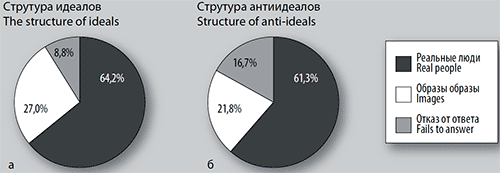
Fig. 1 (a, b). The structure of ideals and anti-ideals of students in secondary and high schools (per cent)
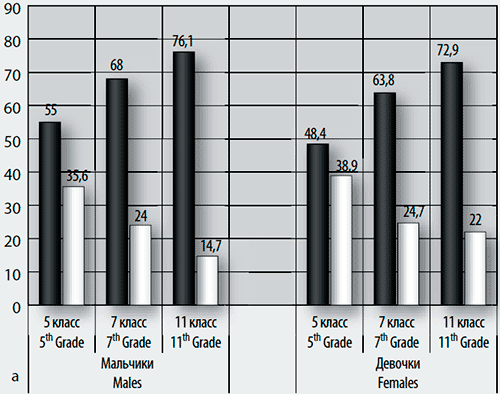
Fig. 2a. Age dynamics of the bars in male and female student ideals structure (per cent of the total number of answers in each age group)
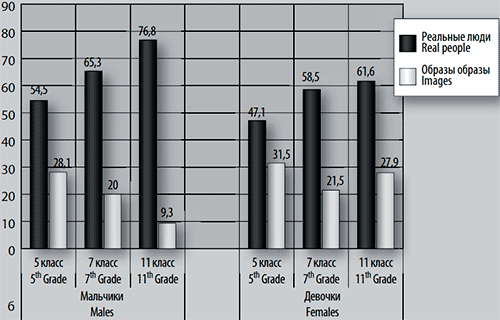
Fig. 2b. Age dynamics of the bars in male and female student anti-ideals structure (per cent of the total number of answers in each age group)
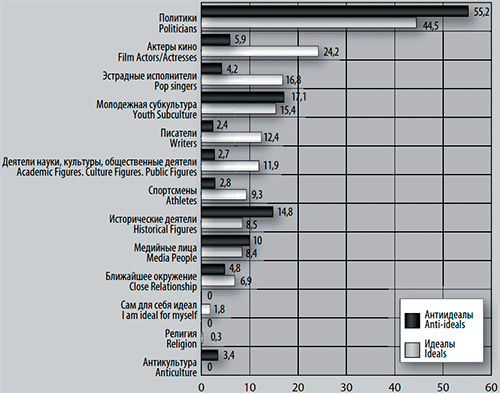
Fig. 3. Respondents’ preferences in the personae groups in «Real People» bar in the structure of ideals and anti-ideals in 5th-11th grade students (respondents, per cent)
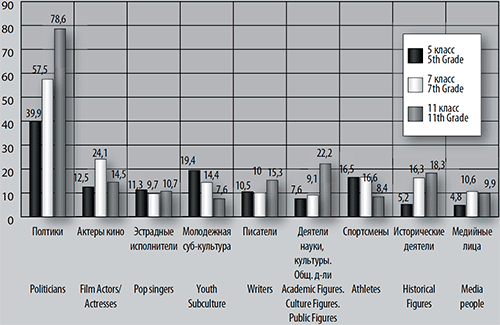
Fig. 4a. Dynamics of personae group importance in the ideal structure in «Real People» bar in 5th-11th grade male students (respondents, per cent)
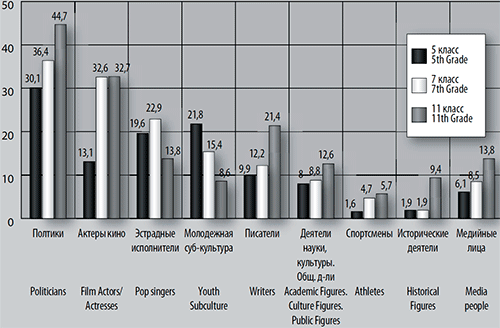
Fig. 4b. Dynamics of personae group importance in the ideal structure in «Real People» bar in 5th- 11th grade female students (respondents, per cent)
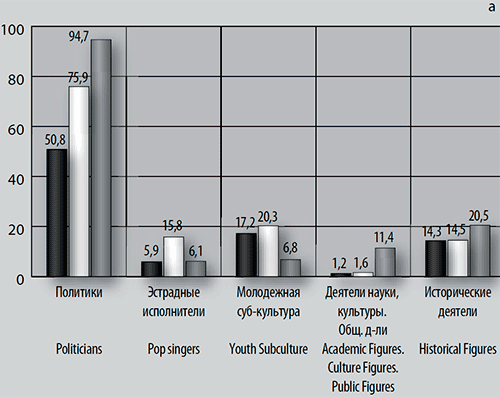
Fig. 5a. Dynamics of personae group importance in the anti-ideal structure in «Real People» bar in 5th-11th grade male students (respondents, per cent)

Fig. 5b. Dynamics of personae group importance in the anti-ideal structure in «Real People» bar in 5th-11th grade female students (respondents, per cent)
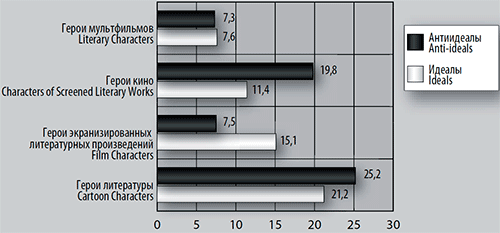
Fig. 6. Group importance in the ideal and anti-ideal structure in «Images» bar in secondary and high school students (respondents. per cent).
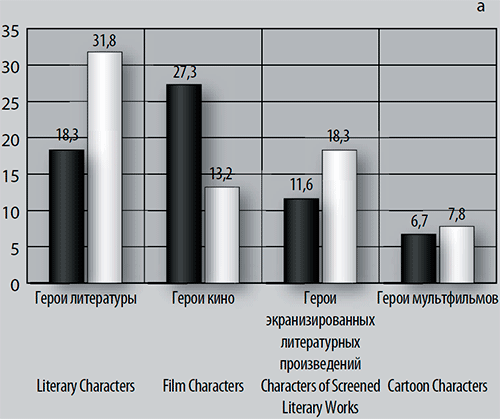
Fig. 7а. Differences of the selected groups of «Images» bar in the ideals structure of male and female students (per cent) (Р<.05)
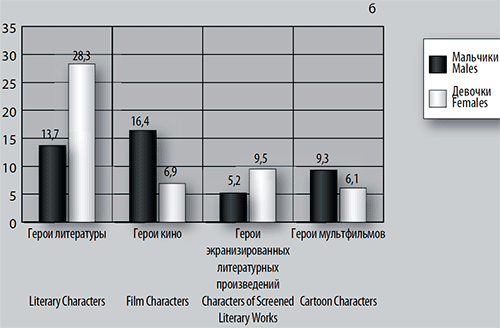
Fig. 7b. Differences of the selected groups of «Images» bar in the anti-ideals structure of male and female students (per cent) (Р<.05)
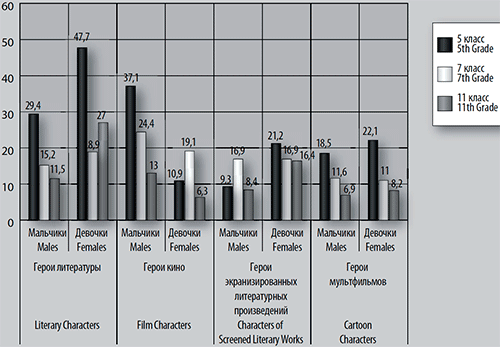
Fig. 8. Age dynamics of the importance of «Images” bar in the structure of ideals in secondary and high school students (per cent)
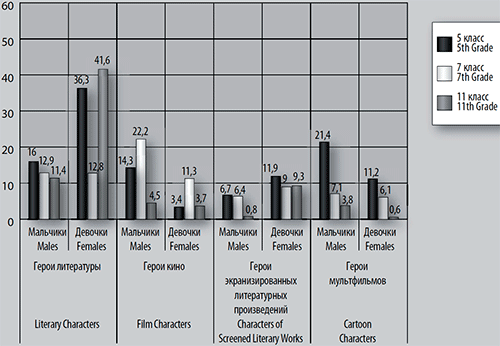
Fig. 9. Age dynamics of the importance of «Images” bar in the structure of anti-ideals in secondary and high school students (per cent)
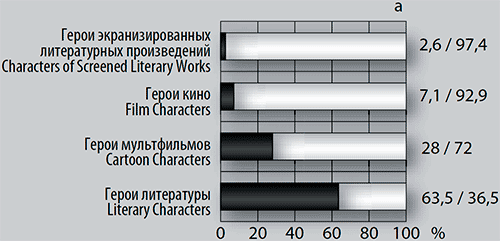
Fig. 10a. The ratio of native and foreign representatives in the dominant groups of «Real People» bar in the ideals of adolescents (per cent)

Fig. 10b. The ratio of native and foreign representatives in the dominant groups of «Real People» bar in theanti- ideals of adolescents (per cent)
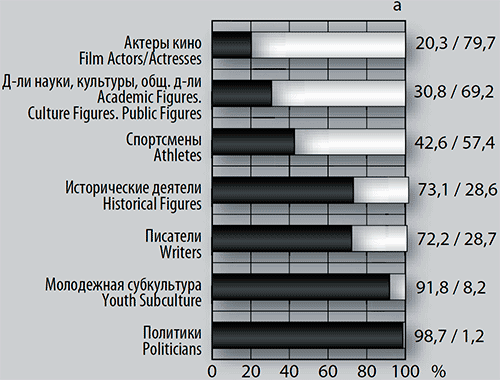
Fig. 11a. The ratio of native and foreign representatives in the dominant groups of «Images» bar in the ideals of adolescents (per cent)
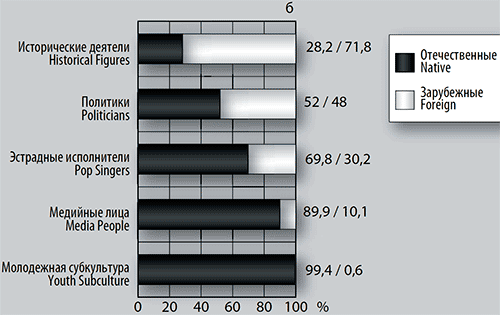
Fig. 11b. The ratio of native and foreign representatives in the dominant groups of «Images» bar in the anti-ideals of adolescents (per cent)
Table 1. Distribution of ideals and anti-ideals male and female students in "male" and "female" personae (number of answers, per cent)
|
Ideals |
Total |
Males |
Females |
Р= |
|
Real People Bar |
||||
|
Male Personae |
84.2 |
98.4 |
69.2 |
.0000 |
|
Female Personae |
15.8 |
2.8 |
30.8 |
.0000 |
|
Image Bar |
||||
|
Male Personae |
79.7 |
96.7 |
60.6 |
.0000 |
|
Female Personae |
20.3 |
3.3 |
38.1 |
.0000 |
|
Anti-Ideals |
Total |
Males |
Females |
Р= |
|
Real People Bar |
||||
|
Male Personae |
85.7 |
91.5 |
79.5 |
.0000 |
|
Female Personae |
14.3 |
8.5 |
20.5 |
.0000 |
|
Image Bar |
||||
|
Male Personae |
86.3 |
94.0 |
78.9 |
.0000 |
|
Female Personae |
13.7 |
6.0 |
21.1 |
.0000 |
Table 2.
|
|
Personae |
||||||
|
Male |
Female |
Male |
Female |
Male |
Female |
||
|
Ideals |
Gender |
5th Grade |
7th Grade |
11th Grade |
|||
|
Real People |
M |
97,2 |
2,8 |
97,7 |
2,4 |
96,8 |
3,2 |
|
F |
71,8 |
28,2 |
73,2 |
26,8 |
76,1 |
23,9 |
|
|
Images |
M |
96,7 |
3,3 |
95,0 |
5,0 |
98,0 |
2,0 |
|
F |
60,9 |
39,1 |
67,7 |
26,8 |
73,8 |
32,1 |
|
|
Anti-Ideals |
Gender |
5th Grade |
7th Grade |
11th Grade |
|||
|
Real People |
M |
97,0 |
3,0 |
90,2 |
9,8 |
93,2 |
6,8 |
|
F |
79,9 |
20,1 |
81,0 |
19,0 |
87,2 |
12,0 |
|
|
Images |
M |
93,4 |
6,6 |
93,1 |
7,4 |
86,5 |
13,5 |
|
F |
72,4 |
27,0 |
83,9 |
16,1 |
88,8 |
11,2 |
|
Table 3. «Male» and «female» personae in the dominant groups of the «Real People» bar in the ideals of male and female students in 5th. 7th and 11th grades (per cent)
|
Gender |
Male Student |
Female Student |
||
|
Group |
Male |
Female |
Male |
Female |
|
5th Grade |
||||
|
Group Total |
97,2 |
2,8 |
71,8 |
28,2 |
|
Politicians |
100 |
0,0 |
100 |
0,0 |
|
Youth Subculture |
95,8 |
4,1 |
0,0 |
100,0 |
|
Sport |
100,0 |
0,0 |
–* |
– |
|
Pop Singers |
– |
– |
41,0 |
59,0 |
|
7th Grade |
||||
|
Group Total |
97,7 |
2,4 |
73,2 |
26,8 |
|
Politicians |
100 |
0,0 |
100 |
0,0 |
|
Youth Subculture |
95,8 |
4,2 |
38,8 |
61,2 |
|
Sport |
100,0 |
0,0 |
– |
– |
|
Pop Singers |
– |
– |
56,2 |
43,8 |
|
Film Actors/Actresses |
100 |
0,0 |
56,7 |
43,3 |
|
Historical Figures |
100 |
0,0 |
– |
– |
|
11th Grade |
||||
|
Group Total |
96,8 |
3,2 |
76,1 |
23,9 |
|
Politicians |
100 |
0,0 |
100 |
0,0 |
|
Writers |
– |
– |
94,1 |
5,9 |
|
Media People |
– |
– |
50,0 |
50,0 |
|
Historical Figures |
100 |
0,0 |
– |
– |
|
Film Actors/Actresses |
– |
– |
51,9 |
48,1 |
|
Academic Figures. Culture Figures. Public Figures |
100 |
0,0 |
– |
– |
* – the group is not dominant in the structure of ideals.
Table 4. "Male" and "female" personae in the dominant groups of the "Real People" bar in the anti-ideals in male and female students of 5th. 7th and 11th grades (per cent)
|
Gender |
Male Student |
Female Student |
||
|
Group |
Male |
Female |
Male |
Female |
|
5th Grade |
||||
|
Group Total |
97.0 |
3.0 |
79.9 |
20.1 |
|
Politicians |
96.7 |
3.3 |
92.0 |
8.0 |
|
Youth Subculture |
92.5 |
7.5 |
59.3 |
40.7 |
|
Sport |
100 |
0.0 |
–* |
– |
|
Pop Singers |
– |
– |
68.5 |
31.5 |
|
7th Grade |
||||
|
Group Total |
90.2 |
9.8 |
81.0 |
19.0 |
|
Politicians |
91.5 |
8.5 |
93.8 |
6.3 |
|
Youth Subculture |
91.7 |
8.3 |
59.4 |
40.6 |
|
Sport |
100 |
0.0 |
– |
– |
|
Pop Singers |
91.8 |
8.2 |
83.3 |
16.7 |
|
11th Grade |
||||
|
Group Total |
93.2 |
6.8 |
87.2 |
12.0 |
|
Politicians |
92.0 |
8.0 |
95.2 |
4.8 |
|
Historical Figures |
100 |
0.0 |
100.0 |
0.0 |
* – the group is not dominant in the structure of anti-ideals
References:
Bozhovich, L.I. (1968) Personality and its development in childhood. (Psychological research). Moscow, Prosveshhenie. 464.
Deschamps, J.-C., & Devos, T. (1998) Regarding the relationship between social and personal identity. Worchel, St., Vorales, F., Paez, D., & Deschamps, J.-C. (Eds.). Social identity: International perspectives. London: SAGE, 1–12. doi: 10.4135/9781446279205.n1
Dois, W. (1994) Social representations in personal identity. Gergen K. Realities and relationships. Soundings in social construction. London, Harvard University Press, 21–26.
Dubrovina, I.V. (Ed.) (1987) Personality development in the transition period: from adolescence to juvenility. [Nauchno-issledovatel’sliy institutt obshchey i pedagogicheskoy psikhologii Akademiya pedagogicheskikh nauk SSSR]. Moscow, Pedagogika, 184.
El’konin, D.B. (1971) On the issue of the periodization of mental development in childhood. [Voprosy psikhologii], 4, 6–20.
Erickson, E. (2006) Identity: youth and crisis. Moscow, Flinta (Series: Library of Foreign Psychology), 342.
Fogelson, R.D. (1982) Person, self and identity. Some anthropological retrospects, circumspects and prospects. In: B. Lee (Ed.) Psychosocial theories of the self. London: Plenum Press, 115–132. doi: 10.1007/978-1-4684-4337-0_5
Galperin, P.Ya. (1999) Introduction to Psychology: textbook for higher school. Moscow, Knizhnyy dom «Universitet», 332.
Gergen, K.J. (1991) The Saturated Self: Dilemmas of Identity in Contemporary Life. Pennsylvania, Penn. university.
Granovetter M.S. (1973) The strength of weak ties. American Journal of Psychology, 78(6), 1360–1380. doi: 10.1086/225469
Karabanova, O.A. (2010) First of all we are to shape a civil identity. [Obrazovatel’naya politika]. 1–2, 9–14.
Kon, I.S. (1989) Psychology of early adolescence: teacher’s book. Moscow, Prosveshchenie, 255.
Korchak, Ya. (1980) How to love children. Minsk, Narodnaya Asveta.
Lerner, R.M., & Bush-Rossnagel, N.A. (Eds.) (1981) Individual as producers of their development: A life-span perspective. New York, NY, Academic Press.
Lerner, R.M., & Lerner, J.V. (1987) Children in their contexts: A goodness-of-fit model. In: J.B. Lancaster, J. Altmann, A.S. Rossi, & L.R. Sherrod (Eds.) Parenting across life-span: Biosocial dimensions. New York, NY: Aldine Publishing Co., 377–404.
Lerner, R.M., Fisher, C.B., & Weinberg, R.A. (2000) Toward a science for and of the people:. promoting civil society through the application of developmental science. Child Psychology, 71(1), 11–20. doi: 10.1111/1467-8624.00113
Martsinkovskaya, T.D., & Dubovskaya, E.M. (2011) Socialization of adolescents and young people in different institutions of socialization and in various sociocultural conditions. Moscow, FIRO.
Portes, A. (1998) Social capital: Its origins and applications in modern sociology. Annual Review of Sociology, 24, 1–24. doi: 10.1146/annurev.soc.24.1.1
Portes, A. (1998) Social capital: Its origins and applications in modern sociology. Annual Review of Sociology, 24, 1–24. doi: 10.1146/annurev.soc.24.1.1
Putnam, R.D. (2002) Democracies in flux: The evolution of social capital in contemporary society. New York, Oxford University Press. doi: 10.1093/0195150899.001.0001
Putnam, R.D. (2002) Democracies in Flux: The Evolution of Social Capital in Contemporary Society. New York, NY, Oxford University Press. doi: 10.1093/0195150899.001.0001
Razuvaeva, T.N. (2015) The path to the ideals of personality: a person-to-person model of research. [Nauchnye vedomosti BelGU]. Series Humanitarian sciences. 12 (209), 26, 152–158.
Rubinshtein, S.L. (1989) Fundamentals of General Psychology. In 2 vols. Vol. 1. Moscow, Pedagogika. 488.
Sobkin, V.S. (1997) A high school student in the world of politics. An empirical study. Moscow, TsSO RAO, 318.
Sobkin, V.S. (2007) The dynamics of the change in reading in the teenage subculture. [Zhurnal Mezhdunarodnogo instituta chteniya im. A.A. Leont’eva № 7]. Moscow, NITs INLOKKS, 8–19.
Sobkin, V.S. (2016) The modern adolescent in social networks. Moscow, Pedagogika, 8, 61–72.
Sobkin, V.S., & Burelomova, A.S. (2011) Ideals and anti-ideals of an adolescent: the role of literary characters. [Sotsiologiya obrazovaniya. Trudy po sotsiologii obrazovaniya]. Vol. XV. Issue XXVII. Moscow, Institut sotsiologii obrazovaniya RAO, 115–129.
Sobkin, V.S., & Kalashnikova, E.A. (2017) Ideas and anti-ideals in students of secondary and high schools. [Chelovek i obrazovanie], 2, 20–28.
Sobkin, V.S., & Mnatsakanyan, M.A. (2016) Comparative analysis of the relation to the political leaders of Russia of two generations of high school male students (based on psychosemantic studies 2004 and 2014). National psychological journal. 4 (24), 79–86. doi: 10.11621/npj.2016.0410
Sobkin, V.S., & Pisarsky, P.S. (1992) Dynamics of artistic preferences of senior pupils. After the materials of sociological research in 1976 and 1991. Moscow, Ministerstvo obrazovaniya RF, 79.
Sobkin, V.S., & Pisarsky, P.S. (1992) Sociocultural analysis of the educational situation in the megalopolis. Moscow, Ministerstvo obrazovaniya RF, 159.
Sobkin, V.S., Abrosimova, Z.B., Adamchuk, D.V., & Baranova, E.V. (2005) Adolescent: norms, risks, deviations. Moscow, TsSO RAO, 358.
Sobkin, V.S., Mnatsakanyan, M.A. (2015) Attitude to the political leaders of modern high school students (based on psychosemantic research data). [Sotsial’naya psikhologiya i obshchestvo], 6(4), 41–59. doi:10.17759/sps.2015060404.
Sobkin, V.S., Smyslova, M.M., & Burelomova, A.S. (2011) Ideals of a Russian adolescent: from personal characteristics to cultural patterns. [Sotsiologiya obrazovaniya. Trudy po sotsiologii obrazovaniya]. Vol. XV. Issue XXVI. Moscow, Institut sotsiologii obrazovaniya RAO, 7–25.
Tajfel, H., & Turner, J. (1986) The social identity theory of intergroup behavior. S.Worchel, & W.Austin. (Eds). Psychology of inter group relations. Chicago, Nelson-Hall, 7–24.
Turner, J.C., & Oakes, P.J. (1989) Self-categorization Theory and social influence. Paulus P.B. (Еd.). The psychology of group influence. Hillsdale, NJ, Erlbaum, 233–275.
Valsiner, J. (1987) Culture and the Development of Children’s Action: A Cultural Historical Theory of Developmental Psychology. New York, NY, Wiley.
Valsiner, J. (2008) The social and the cultural: Where do they meet? Meaning in action: Constructions, narratives, and representations. Tokyo, Springer, 273–287.
Viaut, А. (2014) Catégorisation des langues minoritaires en Russie et dans l’espace post-soviétique. Boudreaux: Maison des sciences de l’homme d’Aquitaine.
Vygotsky, L.S. (1983) Development of the human psyche and world outlook of the child. [Sobranie sochineniy]. In 6 Vols. Vol. 3. Moscow, Pedagogika.
Vygotsky, L.S. (1984) Pedology of aa adolescent. [Sobranie sochineniy]. In 6 Vols. Vol. 4. Child psychology. Moscow, 6–242.
For citing this article:
Sobkin V.S., Kalashnikova E.A. (2017). Ideals and anti-ideals students of the basic and senior school. National Psychological Journal. 3, 121-135.


